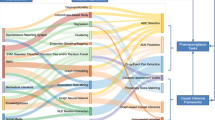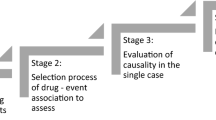Abstract
Causality in pharmacovigilance is a difficult and time consuming exercise. This paper presents the challenges in determining causation by drug therapy. The first is that causation is complex and needs to be viewed from the context of the patient treated, rather than the drug product. Multiple causal vectors should be considered if we are to tackle the many issues involved in, for example, medication error and the many other factors that lead to bad outcomes from therapy, including failure to recognise known risk factors. The aim of pharmacovigilance is not only a bureaucratic exercise in public health norms, but is mainly concerned with small minorities of statistical outliers—and even individuals—whose experiences from harms may together form messages about causation that will prevent further at-risk patients from exposure, or at least assist with earlier recognition of drug-related harm and better management of such harm. This requires more time, more data, more analysis and more patient and clinical involvement in reporting useful clinical detail. The paradigm shift back towards gathering more case data relating to possible causation can be selective and would not be just retrogressive, nor necessarily too costly. Greater transparency of hypotheses and availability of anonymised case data will enrol more expertise into evaluations and hypothesis testing, and the provision of more complete and useful information should reduce clinical burdens from bad patient outcomes as well as their overall costs to society.
Similar content being viewed by others
References
Finney DJ. An international drug safety programme. J New Drugs. 1963;3:262–5.
Edwards IR, Lindquist M (eds) Pharmacovigilance: critiques and ways forward (2017). ISBN 978-3-319-40399-1 ISBN 978-3-319-40400-4 (eBook),pp v–vii. doi:10.1007/978-3-319-40400-4.
Bate A, Lindquist M, Edwards IR, Olsson S, Orre R, Lansner A, De Freitas RM. A Bayesian neural network method for adverse drug reaction signal generation. Eur J Clin Pharmacol. 1998;54:315–21.
Meyboom RH, Egberts AC, Edwards IR, et al. Principles of signal detection in pharmacovigilance. Drug Saf. 1997;16:35–365.
Agbabiaka TB, Savovic J, Ernst E. Methods for causality assessment of adverse drug reactions: a systematic review. Drug Saf. 2008;31(1):21–37.
Théophile H, Arimone Y, Miremont-Salamé G, et al. Comparison of three methods (consensual expert judgement), (algorithmic and probabilistic approaches) of causality assessment of adverse drug reactions. Drug Saf. 2010;33:1045. doi:10.2165/11537780-000000000-00000.
von Elm E, Altman DG, Egger M, Pocock SJ, Gotzsche PC, Vandenbroucke JP. The Strengthening the Reporting of Observational Studies in Epidemiology (STROBE) statement: guidelines for reporting observational studies. Lancet. 2007;370:1453–7. doi:10.1016/S0140-6736(07)61602-X.
Vandenbroucke JP, von Elm E, Altman DG, Gotzsche PC, Mulrow CD, Pocock SJ, Poole C, Schlesselman JJ, Egger M. Strengthening the Reporting of Observational Studies in Epidemiology (STROBE): explanation and elaboration. PLoS Med. 2007;4:e297. doi:10.1371/journal.pmed.0040297.
Paludetto M-N, Olivier-Abbal P, Montastruc J-L. Is spontaneous reporting always the most important information supporting drug withdrawals for pharmacovigilance reasons in France? Pharmacoepidemiol Drug Saf. 2012;21(12):1289–94.
McNaughton R, Huet G, Shakir S. An investigation into drug products withdrawal from the EU market between 2002 and 2011 for safety reasons and the evidence used to support the decision-making. BMJ Open. 2014;4:e004221. doi:10.1136/bmjopen-2013-004221.
Whitehead AN. Science and philosophy (Philosophical Society. Ebook) New York; 1948 (ISBN: 978-1-4976-7615-2).
Popper, K. The logic of scientific discovery (Taylor & Francis e-Library ed.). London: Routledge/Taylor & Francis e-Library; 2005. pp. 47–50 (Section 6 footnote *3 ISBN 0203994620).
Tuttle J, Chen RT, Rantala H, Cherry JD, Rhodes PH, Hadler S. The risk of Guillain-Barré syndrome after tetanus-toxoid-containing vaccines in adults and children in the United States. Am J Public Health. 1997;87(12):2045–8.
Aronson JK, Hauben M. Anecdotes that provide definitive evidence. BMJ. 2006;333(7581):1267–9.
Hitchcock C. Probabilistic causation. http://plato.stanford.edu/entries/causation-probabilistic/#CauMarCon.508.Accessed 22nd Sept 2016.
Taleb NN. The black swan. New York: Random House; 2010. ISBN 978-0-679-60418-1.
Edwards IR. What are the real lessons to be learned from Vioxx? Drug Saf. 2005;28(8):651–8.
Coulter DM, Edwards IR, Savage RL. Survey of neurological problems with amiodarone in the New Zealand Intensive Medicines Monitoring Programme. N Z Med J. 1990;103(885):98–100.
Aronson JK, Ferner RE. Joining the DoTS: new approach to classifying adverse drug reactions. BMJ. 2003;327(7425):1222–5.
Ferner RE, Aronson JA. EIDOS: a mechanistic classification of adverse drug effects. Drug Saf. 2010;33:15–23.
Hill AB. The environment and disease: association or causation? Proc R Soc Med. 1965;58:295–300.
Howick J, Glasziou P, Aronson JK. The evolution of evidence hierarchies: what can Bradford Hill’s ‘Guidelines for Causation’ contribute? J R Soc Med. 2009;102:186–94.
Castor O, Edwards IR. Reflections on attribution and decisions in pharmacovigilance. Drug Saf. 2010;33(10):1–5.
Effective communications in pharmacovigilance: the Erice declaration. http://www.who-umc.org/graphics/24752.pdf Accessed 10 Jan 2017.
Author information
Authors and Affiliations
Corresponding author
Ethics declarations
Funding
No sources of funding were used to assist in the preparation of this article.
Conflicts of interest
I. Ralph Edwards has no conflicts of interest that are directly relevant to the content of this article.
Rights and permissions
About this article
Cite this article
Ralph Edwards, I. Causality Assessment in Pharmacovigilance: Still a Challenge. Drug Saf 40, 365–372 (2017). https://doi.org/10.1007/s40264-017-0509-2
Published:
Issue Date:
DOI: https://doi.org/10.1007/s40264-017-0509-2




